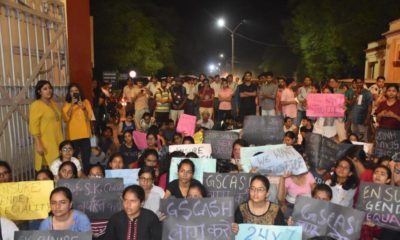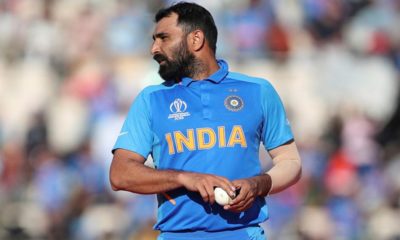Feature
Nearly 70 percent citizens of this country are victims of sexual harassment

Nearly 71 per cent of Australians have been victims of sexual harassment at some point in their lives, a report published on Wednesday by the Australian Human Rights Commission said.

One in every three have experienced it at work in the last five years, Efe news quoted the study as saying.
Sex Discrimination Commissioner Kate Jenkins indicated in the report that sexual harassment is generally perpetrated by a man and “in many cases it is ongoing over an extended period”.
The main forms of sexual harassment cited in the study are sexual jokes and comments, inappropriate physical contact and rape.
At least 23 per cent of women have been victims of an attempt or an act of rape or sexual assault in their lives, the report said, adding that 89 per cent of women have also suffered other types of harassment.

The study also reveals that more than 85 per cent of women and 56 per cent of men under the age of 15 say they have been sexually harassed at least once.
The rate of sexual harassment is higher among people between 18 and 29 years old while indigenous Australians are the most vulnerable to these crimes, according to the research.
The data adds that 83 per cent of homosexuals and 90 per cent of bisexuals have been victims of sexual harassment compared to 70 per cent of heterosexuals, while 68 per cent of disabled people have been sexually harassed at some points in their lives.

The research indicates that 64 per cent of sexual harassment cases in the workplace are carried out by a single perpetrator who most often is a co-worker at the same level as the victim.
Jenkins stressed that the workplace harassment rate is “particularly high in the information, media and telecommunications industries”.
About 19 per cent of the workers who made a formal complaint on sexual harassment in the workplace were labelled troublemakers, another 18 per cent were isolated or ignored and 17 per cent quit their jobs, while the perpetrator experienced no consequences in 19 per cent of the cases.
Entertainment
Meghalaya Reserves Legalized Gambling and Sports Betting for Tourists

The State Scores Extra High on Gaming-Friendly Industry Index
Meghalaya scored 92.85 out of 100 possible points in a Gaming Industry Index and proved to be India’s most gaming-friendly state following its recent profound legislation changes over the field allowing land-based and online gaming, including games of chance, under a licensing regime.
The index by the UK India Business Council (UKIBC) uses a scale of 0 to 100 to measure the level of legalisation on gambling and betting achieved by a state based on the scores over a set of seven different games – lottery, horse racing, betting on sports, poker, rummy, casino and fantasy sports
Starting from February last year, Meghalaya became the third state in India’s northeast to legalise gambling and betting after Sikkim and Nagaland. After consultations with the UKIBC, the state proceeded with the adoption of the Meghalaya Regulation of Gaming Act, 2021 and the nullification of the Meghalaya Prevention of Gambling Act, 1970. Subsequently in December, the Meghalaya Regulation of Gaming Rules, 2021 were notified and came into force.
All for the Tourists
The move to legalise and license various forms of offline and online betting and gambling in Meghalaya is aimed at boosting tourism and creating jobs, and altogether raising taxation revenues for the northeastern state. At the same time, the opportunities to bet and gamble legally will be reserved only for tourists and visitors.
“We came out with a Gaming Act and subsequently framed the Regulation of Gaming Rules, 2021. The government will accordingly issue licenses to operate games of skill and chance, both online and offline,” said James P. K. Sangma, Meghalaya State Law and Taxation Minister speaking in the capital city of Shillong. “But the legalized gambling and gaming will only be for tourists and not residents of Meghalaya,” he continued.
To be allowed to play, tourists and people visiting the state for work or business purposes will have to prove their non-resident status by presenting appropriate documents, in a process similar to a bank KYC (Know Your Customer) procedure.
Meghalaya Reaches Out to a Vast Market
With 140 millions of people in India estimated to bet regularly on sports, and a total of 370 million desi bettors around prominent sporting events, as per data from one of the latest reports by Esse N Videri, Meghalaya is set to reach out and take a piece of a vast market.
Estimates on the financial value of India’s sports betting market, combined across all types of offline channels and online sports and cricket predictions and betting platforms, speak about amounts between $130 and $150 billion (roughly between ₹9.7 and ₹11.5 lakh crore).
Andhra Pradesh, Telangana and Delhi are shown to deliver the highest number of bettors and Meghalaya can count on substantial tourists flow from their betting circles. The sports betting communities of Karnataka, Maharashtra, Uttar Pradesh and Haryana are also not to be underestimated.
Among the sports, cricket is most popular, registering 68 percent of the total bet count analyzed by Esse N Videri. Football takes second position with 11 percent of the bets, followed by betting on FIFA at 7 percent and on eCricket at 5 percent. The last position in the Top 5 of popular sports for betting in India is taken by tennis with 3 percent of the bet count.
Local Citizens will Still have Their Teer Betting
Meghalaya residents will still be permitted to participate in teer betting over arrow-shooting results. Teer is a traditional method of gambling, somewhat similar to a lottery draw, and held under the rules of the Meghalaya Regulation of the Game of Arrow Shooting and the Sale of Teer Tickets Act, 2018.
Teer includes bettors wagering on the number of arrows that reach the target which is placed about 50 meters away from a team of 20 archers positioned in a semicircle.
The archers shoot volleys of arrows at the target for ten minutes, and players place their bets choosing a number between 0 and 99 trying to guess the last two digits of the number of arrows that successfully pierce the target.
If, for example, the number of hits is 256, anyone who has bet on 56 wins an amount eight times bigger than their wager.























